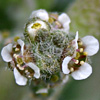Anastatica is found in arid areas in the Negev and Sahara Desert, including parts of North Africa and regions of Egypt, Israel, Iraq, Jordan, Pakistan, and Iran.
After the rainy season, the plant dries up, dropping leaves and curling branches into a tight ball, and dies. Within the ball, the fruits remain attached and closed, protecting the seeds and preventing them from being dispersed prematurely. The seeds are very hardy and can remain dormant for years. Wetted again in a later rainy season, the ball uncurls and the capsular fruits open (dehisce) to disperse the seeds. If water is sufficient, the dispersed seeds germinate within hours. A fraction of the seeds are dispersed in the vicinity of the parent plant by raindrops hitting a spoon-like appendix on the seeds. The seeds have a sticky coat that helps them adhere to the soil, but they also may be carried downstream by surface wash. However, seeds swept downstream do not survive.
The process of curling and uncurling is completely reversible and can be repeated many times. The ability of the plant to do this is attributed to the presence of trehalose, a disaccharide sugar involved in several mechanisms of cryptobiosis. Although the rehydrated plant sometimes is described as putting out new leaves, flowers, and fruits, this is disputed; instead, the seeds may sometimes germinate and sprout new plants while still seated in the fruit on the dead parent plant.
Anastatica has been described as the most famous tumble weed. Once dry, the ball is said to become detached and is dispersed by wind. This tumbleweed habit has been interpreted as a mechanism of avoiding burial in dunes. However, Anastatica may possess this habit only in the literature] or tumble only rarely, if uprooted by accident.
http://en.wikipedia.org/wiki/Anastatica






